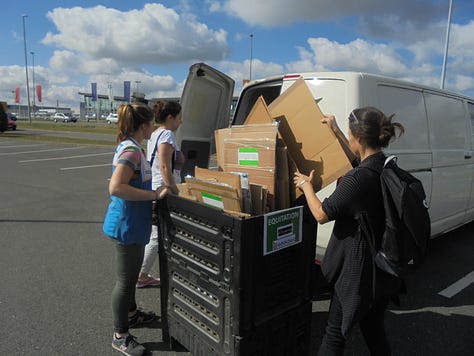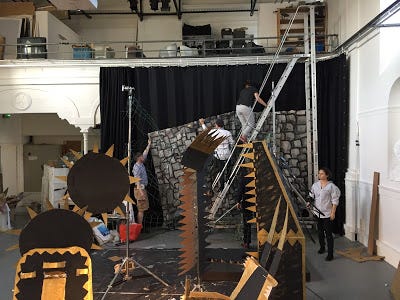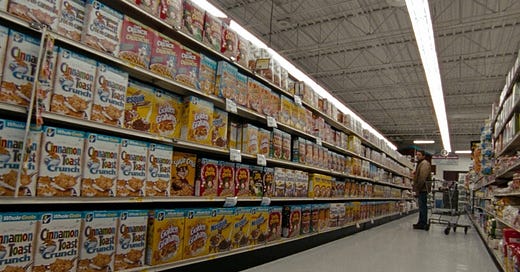◡◶▿ MAPS03 | Cardboard 1
📦 It's cheap and flexible, and it smells good. Why not make your movie with it? Part 1 of 2. Plus: Roger Corman. | Maps, Flaps, & Infinite Wallpaper Week 3
Cardboard! That’s the topic of today’s “esoteric filmmaking lesson.” And next week’s! A two-parter.
First, a glimpse back to last week’s lesson, when we learned how:
The camera will crush your beautiful set construction into a flat, glowing pancake.
Expansion, contraction, furnishing, ornamentation, and suggestion are just some of the steps you can take to bake your movie’s space right in.
Physical space is a necessary consideration if you want your actors to breathe.
Conceptual space is necessary if your crew’s ideas are to breathe.
Missed a week? Joined late? Don’t worry about reading these lessons out of order. Each functions independently. They are sent in a sensible sequence but hardly reliant on it.
So. Today, we’ll have a look at cardboard. We’ve spoken about cardboard before, haven’t we? Three years ago? About how you might ‘justify’ the use of cardboard in your set design and construction. Not that you need to justify it on any moral or aesthetic grounds, but rather help the cardboard find its place.
Perhaps you’ll revisit that full micro-essay before or after today’s cardboard-themed lesson. I recommend it!
But today. Today we’ll look at:
📦 Why cardboard is so great.
🐺 Potato Wolf, Paper Tiger, and the daft politics of cardboard scenery.
🧠 How cardboard thinks - and jokes.
🤝 Production sympathy and the cardboard alienation effect.
Brilliant! Good.
Please forward this lesson to someone you know will appreciate it.









Cardboard
You can hear me deliver this lesson by scrolling up to the header and clicking Listen and/or the play ▸ button.
Cardboard is cheap and flexible, and it smells good.
Cardboard and its slimmer brother, paper, are invaluable tools for the set designer. Cardboard and paper are invaluable tools particularly for the set designer who tolerates or even values wobbliness.
Cardboard and paper come in thin slices. They sit neatly in the plump sandwich bap of your production. Cardboard and paper conserve space for movement and for other visual and metaphysical matter. Paper is good, but cardboard is very good because it is both slim and clunky.
Cardboard and paper are invaluable tools because the movie canvas is ultimately two-dimensional. Using any material thicker or with more dimensions than cardboard or paper is overkill. Using bricks, wood, or concrete is usually a waste of money and muscle power.
The filmmaker can conjure a movie’s world with camera movement across paper. The set designer can conjure infinity using wallpaper. Together, the filmmaker and her set designer can create a vast (or tiny) universe of infinite (or finite) interlocking (or discrete) spaces using only cardboard. And gaffer tape.
A bold word or phrase indicates that an instruction of the same name and concept exists elsewhere in this module.
“Cardboard consciousness”
“It was La Boheme in a linoleum space on East 23rd Street, with cardboard sets, home made costumes, and a pantheon of loudmouthed stars who were too young to realize how beautiful they were,” says Walter Robinson. He is talking about Potato Wolf. Potato Wolf was a public access TV show created by members of the Colaborative Projects (Colab) collective. “It was radical politics and absurdist comedy, fervid and amateur, and not altogether sure whether it should pretend to be real or not.”
The artists - and particularly artist Ellen Cooper, it seems - described their aesthetic as “cardboard consciousness.” More particularly still, the Brooklyn Information & Culture (BRIC) defines “cardboard consciousness” as a “style of shooting that created a tacky, lo-fi aesthetic and was used by Colaborative Projects (Colab) while filming their show Potato Wolf TV.” A neighbouring group, Paper Tiger Television (PTTV), also adopted this “unique, handmade, irreverent aesthetic.”
Cardboard consciousness seems to embody a range of aesthetic and political goals, ideals, and agitations:
Potato Wolf embraced radical politics and ontological doubt.
PTTV sought
“information equity” and
“public awareness of the negative influence of mass media” and
“involving people” and
things like that.
How does cardboard embody this consciousness? Achieve these aims?
Affordability. Cardboard is free if you know where (and when) to look. Making it equitable.
Silliness:
The palpable impermanence of cardboard newsrooms and skyscrapers, the hollow authority of cardboard walls, cardboard’s clumsy (fat-fingered) impersonations of conventional furnitures and machines. (Just as Francis Dove’s clunkyism was ‘sarcastic about certainty.’)
Cardboard as the bare bones of our structures and infrastructures. Absurd skeletons!
Highlighting the absurdity of economic inequality. Everybody needs a place to sleep. Everybody needs lunch. What if Everybody had to make their own version of The Bourne Identity (2002)?
Direct participation. Lower boundaries to film set entry. The economic stakes are lower. The aesthetic stakes are unaligned with ideals of quality.
Participants may still need to grapple with the director’s aesthetic preferences! However, the filmmaker who embraces cardboard - and cardboard consciousness in particular - may allow a little more wobble room in her aesthetic requirements.
Audience participation. Cardboard sets signal the make-believe nature of the movie. They realign the audience’s “suspension of disbelief” to create a collaborative belief system.
This collaborative belief system is founded on faith in the pretend1; on a participatory submission to the imaginative space of others while maintaining conscious production sympathy, resulting in a kind of cardboard alienation effect.
It helps that cardboard comes from trees. Trees have humour. Trees are wobbly monuments. Trees are equitable and participatory!
Please share your thoughts, queries, and exercises from this week’s lesson in the comments.
Roger Corman
I suppose you’ve heard that Roger Corman has died. He was 98! It’s terribly moving. A bit like when Godard died. I hope you’re ok.
Corman was a compulsive filmmaker. The missing link between Irving Thalberg (booo) and Ed Wood (👍). A tinkerer and improviser who saw films inside out and was more sympathetic to the audience’s desires (or tolerances) than to lofty conceptions of art. A communicator and apparently decent bloke who believed in young talent, sharing his good fortune, and giving folk a chance.
The news has come in too late to write much about him. But I have been surprised to see how vocal the internet has been about his loss. I didn’t realise he was so affixed in the public mind! Lots of people have a story to share about him.
Whether you’re familiar with his thing or not, I urge you to check these stories and study his work. Watch a title that appeals and get lost down a Wikipedia rabbit hole. Start with the DVD extras and work your way back. If you spot an inspiring story, do share, do share!
Next week, we’ll learn some more about cardboard. How to slot it into your film if you’re still unsure it will fit! Have an excellent week.
Class dismissed!
~Graeme Cole.
(Principal)
📹 Unfound Peoples Videotechnic | Cloud-based filmmaking thought. ☁️
🐦 Twitter | ⏰ TikTok | 📸 Instagram | 😐 Facebook | 🎞️ Letterboxd | 🌐 Website
In opposition to the concrete assertions and denials of conventional set design.








Thank you Graeme. Cardboard has been a wobbly backbone of a few of my works, it is liberating stuff, with or without excuses!